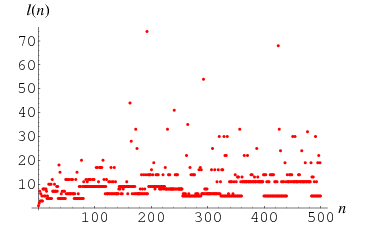


 تاريخ الرياضيات
تاريخ الرياضيات
 الرياضيات في الحضارات المختلفة
الرياضيات في الحضارات المختلفة 
 الرياضيات المتقطعة
الرياضيات المتقطعة
 الجبر
الجبر
 الهندسة
الهندسة 
 المعادلات التفاضلية و التكاملية
المعادلات التفاضلية و التكاملية 
 التحليل
التحليل
 علماء الرياضيات
علماء الرياضيات |
Read More
Date: 24-10-2020
Date: 17-3-2020
Date: 12-12-2020
|
Define the juggler sequence for a positive integer  as the sequence of numbers produced by the iteration
as the sequence of numbers produced by the iteration
 |
(1) |
where  denotes the floor function. For example, the sequence produced starting with the number 77 is 77, 675, 17537, 2322378, 1523, 59436, 243, 3787, 233046, 482, 21, 96, 9, 27, 140, 11, 36, 6, 2, 1.
denotes the floor function. For example, the sequence produced starting with the number 77 is 77, 675, 17537, 2322378, 1523, 59436, 243, 3787, 233046, 482, 21, 96, 9, 27, 140, 11, 36, 6, 2, 1.

Rather surprisingly, all integers appear to eventually reach 1, a conjecture that holds at least up to  (E. W. Weisstein, Jan. 23, 2006). The numbers of steps
(E. W. Weisstein, Jan. 23, 2006). The numbers of steps  needed to reach 1 for starting values of
needed to reach 1 for starting values of  , 2, ... are 0, 1, 6, 2, 5, 2, 4, 2, 7, 7, 4, 7, 4, 7, 6, 3, 4, 3, 9, 3, ... (OEIS A007320), plotted above. The high-water marks for numbers of steps are 0, 1, 6, 7, 9, 11, 17, 19, 43, 73, 75, 80, 88, 96, 107, 131, ... (OEIS A095908), which occur for starting values of 1, 2, 3, 9, 19, 25, 37, 77, 163, 193, 1119, ... (OEIS A094679).
, 2, ... are 0, 1, 6, 2, 5, 2, 4, 2, 7, 7, 4, 7, 4, 7, 6, 3, 4, 3, 9, 3, ... (OEIS A007320), plotted above. The high-water marks for numbers of steps are 0, 1, 6, 7, 9, 11, 17, 19, 43, 73, 75, 80, 88, 96, 107, 131, ... (OEIS A095908), which occur for starting values of 1, 2, 3, 9, 19, 25, 37, 77, 163, 193, 1119, ... (OEIS A094679).
The smallest integers requiring  steps to reach 1 for
steps to reach 1 for  , 2, ... are 1, 2, 4, 16, 7, 5, 3, 9, 33, 19, 81, 25, 353, ... (OEIS A094670).
, 2, ... are 1, 2, 4, 16, 7, 5, 3, 9, 33, 19, 81, 25, 353, ... (OEIS A094670).
REFERENCES:
Pickover, C. A. Computers and the Imagination. New York: St. Martin's Press, p. 232, 1991.
Pickover, C. A. "Juggler Numbers." Ch. 45 in The Mathematics of Oz: Mental Gymnastics from Beyond the Edge. New York: Cambridge University Press, pp. 102-106 and 301-304, 2002.
Sloane, N. J. A. Sequences A007320, A094679, A095908, and A094670 in "The On-Line Encyclopedia of Integer Sequences."



|
|
|
|
التوتر والسرطان.. علماء يحذرون من "صلة خطيرة"
|
|
|
|
|
|
|
مرآة السيارة: مدى دقة عكسها للصورة الصحيحة
|
|
|
|
|
|
|
نحو شراكة وطنية متكاملة.. الأمين العام للعتبة الحسينية يبحث مع وكيل وزارة الخارجية آفاق التعاون المؤسسي
|
|
|